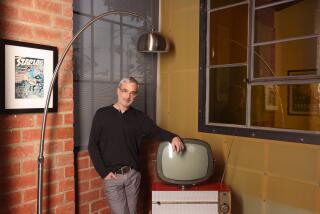Review: Neil deGrasse Tysonâs âCosmosâ a fascinating, fun place to be
It has been at least a while, and possibly in the whole recorded history of the medium, that a blockbuster science series has aired on conventional broadcast television. But there is no time like the present, whether or not such a thing as the present actually exists.
Sunday, which as I write these words is still in what we think of as âthe future,â will see the welcome premiere of Foxâs âCosmos: A Spacetime Odyssey,â Neil deGrasse Tysonâs pumped up remake of and homage to Carl Saganâs beloved âCosmos: A Personal Voyage,â which aired over PBS in 1980 â an eternity in terms of special effects.
Crafted to satisfy those generations of viewers for whom even âThe Empire Strikes Backâ looks quaint and old-fashioned, it is no less thought-provoking for being made to be fun. The different subtitles for the new âCosmosâ and the old reflect the tonal shift â Saganâs original felt intimate for all its enormousness, where Tysonâs, set to Alan Silvestriâs big orchestral score, brings on one show-stopping, high-res digital effect after another. But each approach brings its distinct pleasures.
BEST TV OF 2013 Lloyd | McNamara
The subject â everything that is and how it got that way â is obviously a big one, encompassing not only planets and stars and amoebas and people, but the lenses through which weâve viewed it all. Most important, it celebrates scientific inquiry itself, which Tyson defines as âgenerations of searchers strictly adhering to a simple set of rules: test ideas by experiment and observation; build on those ideas that pass the test; reject the ones that fail; follow the evidence wherever it leads; and question everything.â
There is a kind of missionary urgency palpable here: not merely to get people excited about science, or to honor Sagan, or revive a great television brand, all worthy enough â but to stand up for the scientific method itself, in a world ever more polarized by unscientific orthodoxies. A gauntlet thrown in the face of immovable incuriosity, it aims to get people less scared about what they donât know â to actively get interested in what they donât know â and to kill the idea that knowledge is any way the enemy of wonder or delight or even a sense of the divine.
âThe reality of nature,â says Tyson, âis far more wondrous than anything we can imagine.â
Tyson has spoken often of how religious fundamentalism kills good science. And there is something oddly radical, at this moment, in hearing phrases like âseparation of church and stateâ and âthe chance nature of existenceâ pronounced in a mainstream prime-time television show.
PHOTOS: TV shows and their spinoffs
As a cautionary tale, the opening episode includes a long animated sequence about Giordano Bruno, a late 16th century Franciscan friar who came to see the universe as infinite and the sun as a star, and the stars as suns, orbited by other planets, for which he was excommunicated, and after a while, burned at the stake. In between were years of wandering, imprisonment and torture â âCosmosâ shows you the tools of the Inquisition, chillingly, and offers the words âthought police.â
That we have a successful troublemaker like Seth MacFarlane, of âThe Family Guyâ and other things like âThe Family Guy,â to thank for the series is not surprising. It was MacFarlane who put Tyson and Saganâs widow, Ann Druyan, together with Fox, which will premiere the series across 10 of its networks, including Fox Sports and the movie channel FXM. Subsequent episodes will premiere on Fox and replay on the National Geographic Channel.
Currently attached to New Yorkâs Hayden Planetarium and American Museum of Natural History, Tyson is temperamentally a dog to Saganâs cat. Where the latter was lithe and lean, cool and poetical in his trademark turtlenecks, Tyson is big, enthusiastic and breathless. His nature fits, and perhaps drove, the new seriesâ more muscular presentation. (He wrestled in college.)
If not as weighty or widely known a cultural figure as was Sagan, whom he calls âthe most successful science communicator of the 20th century,â he is as good an ambassador as it has these days. He was the host of the PBS series âNova ScienceNowâ for several seasons, is a regular guest on late-night talk shows, and has rated âas himselfâ cameos on âThe Big Bang Theoryâ and âStargate: Atlantis.â His âStarTalkâ podcasts, often alongside comics like Kristen Schaal, Sarah Silverman, John Hodgman and Eugene Mirman, underscore his jollity.
He begins his journey on the same cliff overlooking the Pacific Ocean that Sagan did â and ends the first episode there as well, with a tribute to his predecessor and role model who took an interest in him as a teenage astronomy prodigy. As in the original, he sets off in an imaginary spaceship to get a better view of things, locating the Earth within the vastness of space and time, overflying extraterrestrial vistas, passing by Voyager and establishing a cosmic address that should work for any mail headed your way from outside the solar system, galaxy, Virgo Supercluster or even the observable universe.
It is a small world, after all, we are shown; our own presence on it would make Methuselah a mayfly. (Or, as Sagan had it back in 1980, âWe are like butterflies who flutter for a day and think it is forever.â) We are shown the incomprehensibility of time as a calendar year, of which all recorded human history occupies only the last 14 seconds.
But cheer up: âWeâre small,â Tyson says. âBut we donât think small.â
Twitter: @LATimesTVLloyd
---------------
âCosmos: A Spacetime Odysseyâ
Where: FS1 and FS2
When: 6 p.m. Sunday
Where: Fox, FX, FXX and National Geographic
When: 9 p.m. Sunday
Rating: TV-PG-DV (may be unsuitable for young children with advisories for suggestive dialogue and violence)
More to Read
The complete guide to home viewing
Get Screen Gab for everything about the TV shows and streaming movies everyoneâs talking about.
You may occasionally receive promotional content from the Los Angeles Times.







